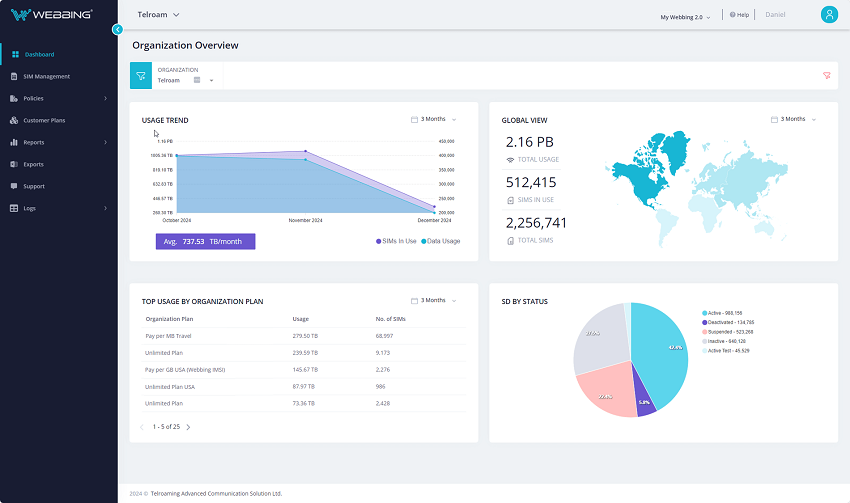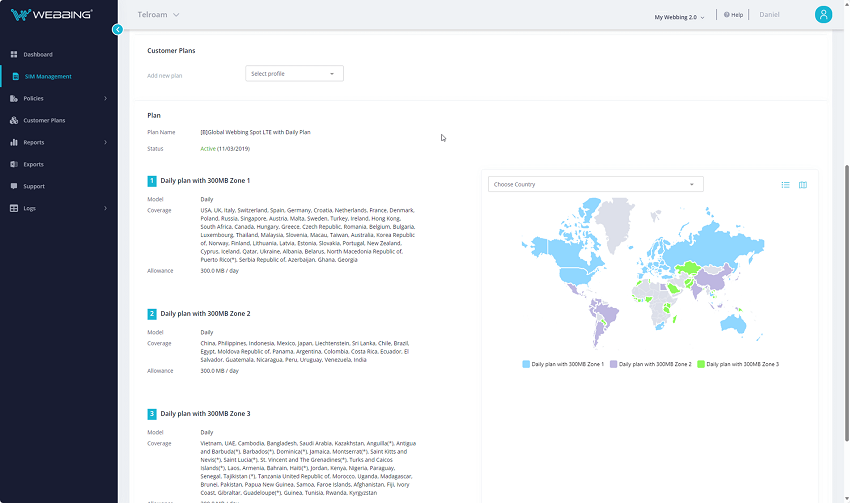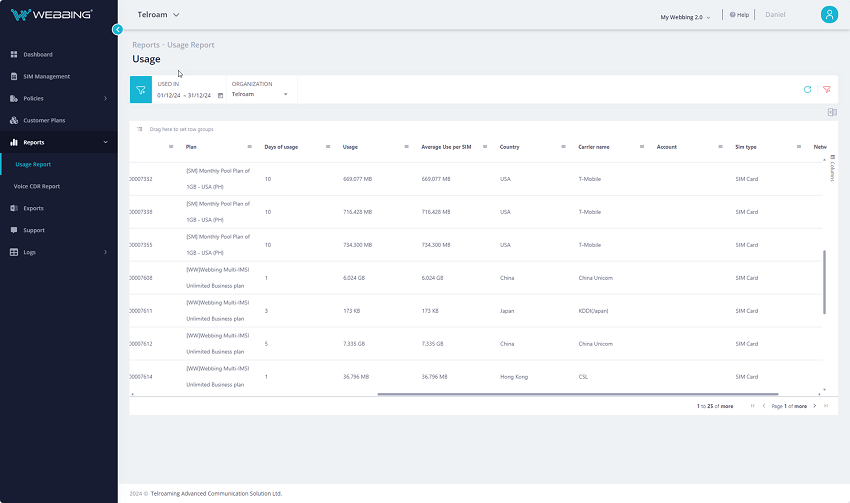The features, flexibility, and benefits of connectivity management platforms for seamless IoT operations
by Yuley Eldar | December 10, 2024
Managing connectivity for IoT deployments can become very complex, especially when it’s a global deployment with thousands of endpoints. Setting up multiple units is challenging and time-consuming even with consumer-grade equipment, let alone IoT projects involving devices with no user interface, often deployed in hard-to-reach locations.
To maintain high performance of their IoT devices and reduce overheads, enterprises require a tool that allows them to manage connectivity at scale. These centralized management solutions are known as Connectivity Management Platforms (CMPs). Since these platforms play such an important role in IoT deployments, some connectivity providers develop and maintain their own CMPs that help their clients control and monitor IoT devices. These platforms and the portals that allow to use them are tightly integrated with the provider’s network infrastructure and services, and oftentimes offer customized features tailored to the specific needs of their clients’ use cases.
A year ago, experts typically categorized CMPs as “thick” or “thin” based on their functionality, but the market is currently undergoing a period of transition. The range of features considered essential for CMPs has expanded significantly, often transforming them into all-encompassing IoT remote management tools, to the point where the term “CMP” itself no longer fully captures the diversity of offerings available. However, let’s take a look at the main functions that such platforms and portals offer and the differentiators that can be crucial when choosing the CMP and connectivity provider altogether.

Key Features of Connectivity Management Platforms for Efficient IoT Deployments
For enterprises rolling out IoT deployments, a connectivity management platform provides many features to control their IoT devices and ensure continuous connectivity. It allows to remotely provision, manage, and monitor IoT devices and includes OTA updates, diagnostics, device configuration, and security management. CMPs’ capabilities of remote control in IoT rollouts are extensive: they allow customers to view their plans and add new users and services, manage all their devices, track their health, performance and data usage, and set up device-specific settings such as data limits. Moreover, they enable businesses to activate and deactivate SIM cards or devices centrally and remotely as needed, which is particularly useful for enterprises that need to manage large fleets of IoT devices.
A key feature is the ability to monitor data usage and other service metrics in real time. Oftentimes CMPs provide analytical tools that enable the extraction of valuable insights and the transformation of raw data into actionable intelligence. The interactive charts and graphs they offer help examine trends, detect patterns, and gain a deeper understanding of connected devices and the data they use.
Another important feature is billing and cost management. Management platforms may offer detailed billing breakdowns, allowing clients to see usage reports by department, device, or project. This level of granularity is crucial for businesses that need to allocate costs across different projects or areas.
Webbing’s connectivity management portal allows customers to configure and control data connectivity for their global fleet of devices. It includes features for monitoring, optimizing data usage, managing support cases, accessing analytics, and much more. You can learn more about these features later in the post.
Streamlining Operations and Support
What’s also important is support and troubleshooting capabilities. Many providers integrate a support ticketing system within their portals, allowing clients to submit issues and communicate directly with customer service teams. Portals may also provide self-service tools for troubleshooting common issues, such as checking network coverage, testing connection speeds, or managing device settings. All this helps enterprises resolve issues more quickly and makes them less dependent on direct support.
By providing businesses with control over their services, management platforms help them streamline day-to-day operations, ensure that their services are aligned with their current needs, avoid unexpected charges and reduce time-to-market for their IoT projects. They also allow to scale service plans easily based on growth or changing needs, which is especially beneficial for enterprises rolling out new IoT devices.
Although most connectivity management platforms provide similar basic functionality, their capabilities may vary quite a lot and have a significant impact when it comes to specific requirements of certain use cases.

In-house Development: Customized Connectivity Management Platform
Some connectivity providers offer their own proprietary CMPs, some use third-party solutions. Management platforms developed in-house are designed to integrate deeply with the provider’s own infrastructure, offering seamless service management. Moreover, some features such as real-time performance tracking or priority service options need to take full advantage of their network capabilities.
This approach also offers more customization options: providers can tailor their CMP to meet the unique needs of the customer. In many cases, features and capabilities are added for certain customers’ usage scenarios. Besides, there may be some verticals that the provider is focusing on, so clients from the relevant industry may get from them better service and more capabilities than from any other MNO or MVNO.
It can cut a lot of red tape in the process, too, since customization does not require additional requests and approvals from third-party vendors.
Webbing provides customized connectivity solutions, and that applies to our connectivity management platform. Developed in-house, it has been serving clients for over 15 years, and our approach has always been to build tailored features designed to address each client’s specific use case.
Integration Capabilities
Businesses use a variety of software tools for managing different aspects of their operations, and APIs allow a CMP to integrate with external systems, such as enterprise resource planning (ERP) systems, customer relationship management (CRM) tools, billing platforms, IoT device management systems etc, ensuring smooth dataflow. Some enterprises may combine two approaches, and both use API for integration with their internal systems and work in the CPM to manage their IoT connectivity.
For all these clients, the API capabilities that the connectivity provider offers will be critical. Quick and easy integration here depends on several factors from the provider side, including the availability of APIs, the protocols and standards used, security mechanisms, and compliance with regulatory requirements.
Scalability and Flexibility
CMPs should be able to scale to accommodate increasing numbers of users, devices, and connectivity types (e.g., adding more IoT devices or expanding to new regions). A CMP with flexible pricing plans and the ability to support multi-network environments will allow organizations to grow without the need to switch platforms as their needs evolve. Aside from being ready for geographic expansion and device scaling, platforms should also be future proof to handle emerging technologies or new use cases. Overall, the more flexible the platform is in every aspect – from features to UI layout, the easier it is to apply to any industry and use case.

Webbing’s Management Portal
As a global data MVNO that delivers innovative enterprise grade connectivity and IoT services, Webbing also provides necessary tools to help customers manage connectivity for their IoT deployments. This includes a state-of-the-art management portal and full API suite that allows automation, policy settings, content control, security controls, advanced role-based permission, and organizational structure.
My Webbing portal is the primary management interface for all Webbing services. It gives customers access to administrative settings to deploy and manage data connectivity for their global fleet of devices. Administrators can manage, monitor, and optimize data usage of each device in real-time, support cases, get advanced analytics and reports, and manage many other Webbing product features. It allows for defining business rules that enable devices to change the carrier automatically in case of location change or connectivity loss, provides visibility to profile usage and network events, and helps manage connected devices in bulks and easily scale global IoT deployments.
Webbing connectivity management platform has been in service for over 15 years and is developed in-house. Along with basic functionality, we invested more time and effort in adding features and capabilities that our customers needed, which other CMPs oftentimes couldn’t offer. Instead of making a “one-size-fits-all” solution, our approach to creating a management tool was always focusing on building every little feature to solve the client’s use case. Much like Webbing connectivity offering in general, My Webbing management portal is as customizable as it can be. Moreover, all users of Webbing platform get access to all new features and can benefit from them.
Every functionality in the platform is also available by API, and if customers have specific requirements, more API functionalities for any systems they might have can be quickly added. We also provide training for accessing the Webbing Portal, so the customer can manage their fleet of devices by themselves, and our customer support teams remain available 24/7 for any assistance they may require, be it adding more devices, changing locations or data plans, or helping schedule maintenance of existing devices.
Contact us today to learn how Webbing’s solutions can optimize your deployments and streamline your IoT connectivity management.




